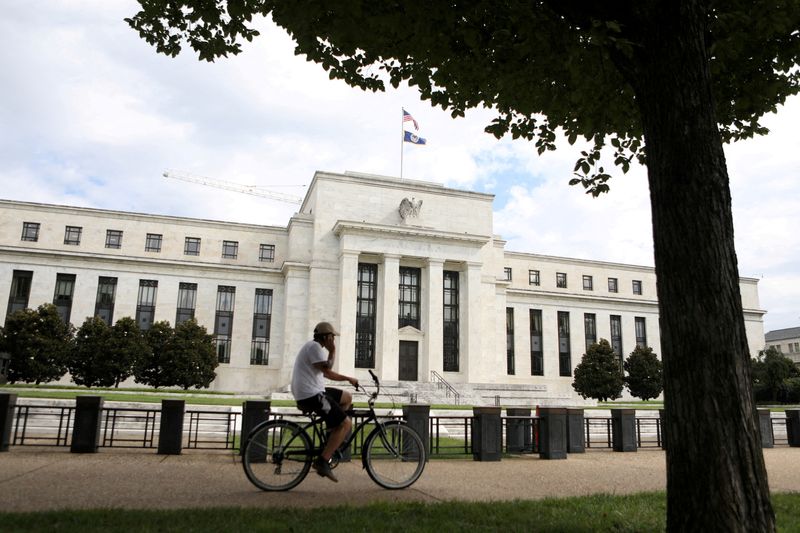
© Reuters. FILE PHOTO: A cyclist passes the Federal Reserve building in Washington, DC, U.S., August 22, 2018. REUTERS/Chris Wattie/File Photo
FED
+0.87%
Add to/Remove from Watchlist
Add to Watchlist
Add Position
Position added successfully to:
Please name your holdings portfolio
Type:
BUY
SELL
Date:
Amount:
Price
Point Value:
Leverage:
1:1
1:10
1:25
1:50
1:100
1:200
1:400
1:500
1:1000
Commission:
Create New Watchlist
Create
Create a new holdings portfolio
Add
Create
+ Add another position
Close
By Howard Schneider
(Reuters) – The Federal Reserve held its benchmark overnight interest rate steady at the Sept. 19-20 policy meeting. Data since then will influence whether the U.S. central bank continues to stand pat at its Oct. 31-Nov. 1 meeting or proceed with another rate increase.
The Fed’s target policy rate has been raised to the 5.25%-5.50% range from near zero in March of 2022, and inflation measured by the Fed’s preferred personal consumption expenditures price index (PCE) was 3.5% in August, compared to a peak of 7% last summer.
Fed Chair Jerome Powell has said the pieces of the low-inflation “puzzle” may be aligning, though the central bank hasn’t declared its inflation fight over.
Here is a guide to some of the numbers shaping the policy debate:
INFLATION (Released Oct. 12, next release Oct. 27):
Consumer price inflation on a year-on-year basis was 3.7% in September, unchanged from August. But the underlying “core” rate, which excludes more volatile goods like food and energy, slowed to 4.1% last month from 4.3% in August, continuing a slow but steady decline. Core measures are important to the Fed because they are considered more indicative of supply and demand conditions in the economy, are less influenced by global commodity prices, and can better capture whether price pressures are spreading or narrowing.
The other key inflation measure fell in August, adding to what many economists feel is likely to be a steady disinflation. The PCE price index, stripped of volatile food and energy costs, rose 3.9% on a year-over-year basis compared to 4.3% in July, and recent month-to-month increases have averaged close to the Fed’s 2% target. The headline rate did increase slightly, from 3.4% to 3.5%, but largely on the basis of energy costs. The Fed uses the headline PCE measure to set its inflation target, but the decline in the “core” index will be seen as evidence of slower price increases ahead.
The fact that recent month-to-month PCE data has been close to the 2% target has been highlighted by even hawkish Fed officials, and may be softening support for any further rate increases.
EMPLOYMENT (Released Oct. 6, next release Nov. 3):
Job growth in September blew past expectations in a confounding turn for Fed officials who thought the labor market had started to cool, likely stiffening the case for an additional rate increase. Employers added 336,000 jobs last month, nearly double what economists polled by Reuters had expected. Revisions to prior months tacked on an additional 119,000 jobs to the July and August totals, upending a trend Fed officials said was a sign of a labor market coming back into balance. The unemployment rate remained steady at 3.8%.
Hourly wages grew at a still brisk 4.2% on a year-over-year basis, though the month-to-month change of 0.2% was more contained.
JOB OPENINGS: (Released Oct. 3, next release Nov. 1)
Powell keeps a close eye on the Labor Department’s Job Openings and Labor Turnover Survey (JOLTS) for information on the imbalance between labor supply and demand, and particularly on the number of job openings for each person without a job but looking for one. That key ratio clung to its downward trend in August as the Fed’s rate hikes have slowed labor market demand. It’s now about 1.5-to-1, compared with the nearly two jobs for every person seeking work during most of 2022. Levels around 1.2 were considered tight for the U.S. labor market before the coronavirus pandemic.
INFLATION EXPECTATIONS (Released Sept. 29, next release Oct. 13)
Consumers’ estimates of what inflation will average over the next 12 months and the next five years fell notably in September, the University of Michigan reported. At the one-year horizon, the inflation expectation fell to 3.2% from 3.5% in August. At five years, the reading fell to 2.8% from 3.0%.
The declines will be comforting to Fed officials who worry that rising inflation expectations can make consumers act in ways that will keep actual inflation higher. The one-year rate, notably, is now around its 40-year average.
RETAIL SALES (Released Sept. 14, next release Oct. 17):
Retail sales rose more than expected in August, increasing 0.6%. While that was largely due to higher gasoline prices, a separate measure of sales more directly related to economic output also rose slightly despite economists’ expectations for it to decline. Even as prior months’ sales were revised lower, the August report showed household spending likely still adding to overall economic growth that has been on the central bank’s radar as an inflationary risk.
Source: Investing.com





























